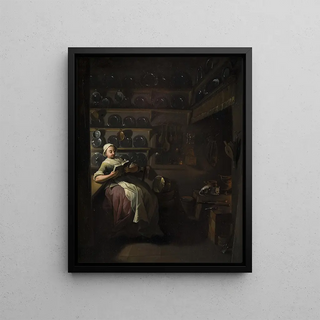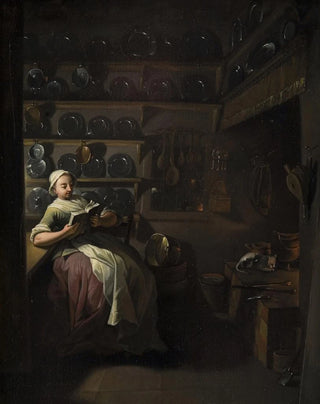Art print | Interior of a kitchen with a girl reading - Jens Juel


View from behind

Frame (optional)
Within the rich and captivating universe of art, certain works manage to capture the very essence of everyday life while revealing unexpected emotional depth. "Interior of a kitchen with a girl reading" by Jens Juel is one of those creations that invites attentive contemplation. This piece, painted in the early 19th century, evokes not only the simplicity of a domestic scene but also the complexity of human relationships. Through the gaze of the young girl immersed in her reading, the viewer is transported to a moment of tranquility, where time seems to stand still. This delicate representation of Scandinavian domestic life reminds us that art has the power to elevate ordinary moments into extraordinary experiences.
Style and uniqueness of the work
Jens Juel's style is characterized by an intimate and realistic approach, where every detail is carefully observed. In "Interior of a kitchen with a girl reading," the natural light entering through the window plays a crucial role, subtly illuminating the young girl’s face and creating soft shadows on the walls. The color palette, dominated by warm and earthy tones, helps establish a soothing and welcoming atmosphere. Juel excels in depicting textures, whether it’s the wood of the furniture or the fabric of the clothing, thus offering a tangible sensation. Focusing on this domestic scene, the artist manages to evoke universal emotions such as curiosity, solitude, and serenity, while celebrating everyday life.
The artist and his influence
Jens Juel, born in Copenhagen in 1784, is considered one of the pioneers of Scandinavian realism. His work is marked by a particular sensitivity to scenes of daily life, which allows him to stand out from his contemporaries. Influenced by the great European masters, Juel developed a unique style that combines technical precision with emotional depth. His perspective on the world around him, imbued with delicacy, paved the way for many artists who followed in his footsteps. By placing the individual at the heart of his compositions, he contributed to human

Matte finish

View from behind

Frame (optional)
Within the rich and captivating universe of art, certain works manage to capture the very essence of everyday life while revealing unexpected emotional depth. "Interior of a kitchen with a girl reading" by Jens Juel is one of those creations that invites attentive contemplation. This piece, painted in the early 19th century, evokes not only the simplicity of a domestic scene but also the complexity of human relationships. Through the gaze of the young girl immersed in her reading, the viewer is transported to a moment of tranquility, where time seems to stand still. This delicate representation of Scandinavian domestic life reminds us that art has the power to elevate ordinary moments into extraordinary experiences.
Style and uniqueness of the work
Jens Juel's style is characterized by an intimate and realistic approach, where every detail is carefully observed. In "Interior of a kitchen with a girl reading," the natural light entering through the window plays a crucial role, subtly illuminating the young girl’s face and creating soft shadows on the walls. The color palette, dominated by warm and earthy tones, helps establish a soothing and welcoming atmosphere. Juel excels in depicting textures, whether it’s the wood of the furniture or the fabric of the clothing, thus offering a tangible sensation. Focusing on this domestic scene, the artist manages to evoke universal emotions such as curiosity, solitude, and serenity, while celebrating everyday life.
The artist and his influence
Jens Juel, born in Copenhagen in 1784, is considered one of the pioneers of Scandinavian realism. His work is marked by a particular sensitivity to scenes of daily life, which allows him to stand out from his contemporaries. Influenced by the great European masters, Juel developed a unique style that combines technical precision with emotional depth. His perspective on the world around him, imbued with delicacy, paved the way for many artists who followed in his footsteps. By placing the individual at the heart of his compositions, he contributed to human






